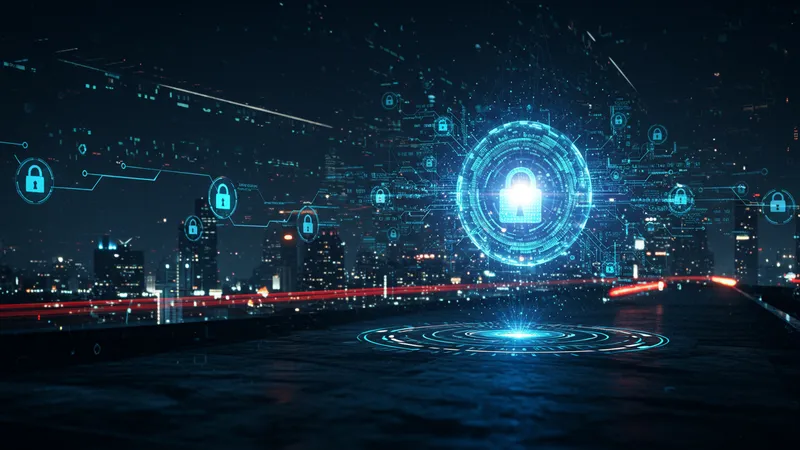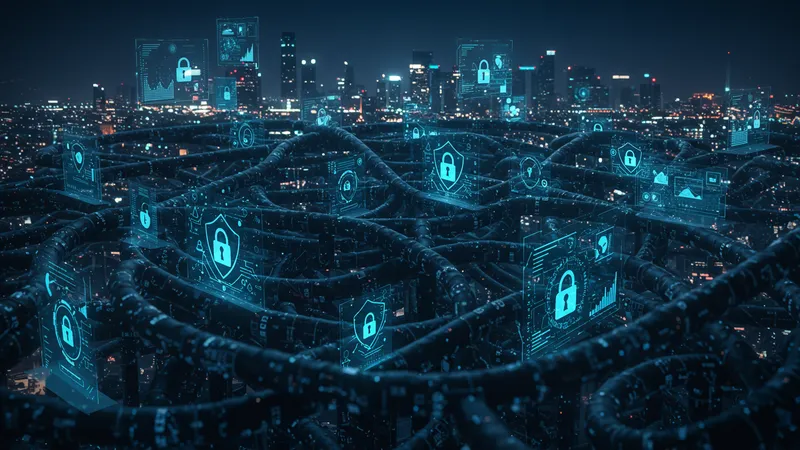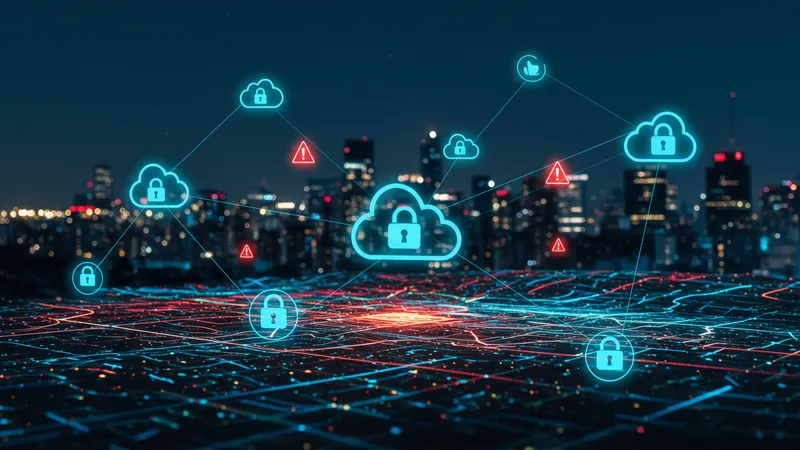

Ever wonder how a simple click can compromise your entire digital life? With cyber threats evolving at lightning speed, your data might be at risk right now without you even knowing it.
In a time where data breaches occur almost daily, understanding cybersecurity has never been more crucial. From small businesses to giant corporations, everyone is a target. Discover why now is the moment to secure your online presence.

You might think your basic antivirus can fend off most cyber threats, but modern hackers are more sophisticated than that. They infiltrate even the tightest of firewalls, leaving no stone unturned. Think you're safe? Think again. But that’s not even the wildest part…
Consider this: a report found that over 85% of small businesses fall victim to cyber-attacks daily, yet many don't even know about it until it's too late. It’s not just about protecting data; it’s about survival. But what happens next might truly shock you…
What happens next shocked even the experts, turning the cybersecurity landscape on its head. Companies are now scrambling to adopt the latest tools and strategies, but are they enough? The answer might surprise you. Follow along to uncover cutting-edge revelations that could save your digital identity.
The year 2023 marked a terrifying benchmark: cyberattacks surpassed traditional crime in financial costs, leaving many stunned. Hackers now have an arsenal of tools that make infiltration shockingly easy, and the numbers reflect this. The increase is not just in volume but also in creativity and persistence.

With ransomware attacks claiming headlines, it's evident cybercriminals are no longer just financial thieves; they're digital terrorists. How they're breaking into networks is evolving, using tactics as simple as phishing emails to complex backend practices. The statistics point to a grim reality, but there's more to uncover.
It turns out, many companies are still using outdated security protocols, blissfully unaware of the ticking time bomb they're sitting on. And those on the cutting edge? Well, they might not be as safe as they believe, due to unforeseen vulnerabilities in supposedly 'unbreakable' systems.
These vulnerabilities have left cybersecurity experts in shock, forcing a major reevaluation of their strategies. But the revelation that comes next might completely change how you view online security. Stick around.
The typical cost of a data breach skyrocketed to $4.24 million this year, according to a report by IBM. That's a hefty price for negligence, but the hidden costs, like reputational damage and client churn, are incalculable. Discovering these numbers pushes companies to reassess their current approaches to cybersecurity.

But here’s the kicker: many businesses still view cybersecurity as a cost center, not a revenue protector. The emphasis is often misplaced, and investments in cybersecurity tools lag behind actual need. It's a dangerous gamble, considering the asymmetrical nature of threats these days.
Furthermore, the impact of a breach can extend far beyond financial costs. Businesses face the risk of losing customer trust and enduring legal repercussions. The high stakes mean reassessing your security posture is more critical than it has ever been. And there’s more at stake than just today’s business — tomorrow’s brand legacy is on the line.
Convinced you’re operating safely? What happens with tomorrow’s threats might say otherwise, proving just how volatile the digital landscape truly is. Let’s delve deeper.
While the cyber world seems bleak, emerging technologies are providing a glimmer of hope. One of these technologies, blockchain, is revolutionizing secure transactions by offering a new transparency and integrity level that was once thought unattainable. It's reshaping various sectors, proving the game isn't over yet.

Another innovation, artificial intelligence, is becoming a sentinel that predicts and counters threats before they occur. AI continues to learn and evolve, its potential to neutralize cyber threats increasing exponentially as more data is fed to these intelligent systems. Here lies the future of adaptive, proactive security.
There’s also an upswing in quantum computing, with its promise to crack the toughest encryptions and deliver an impenetrable shield against cyber trespassers. This brings us closer to a new era of cybersecurity where breaches might become a rareity rather than the norm.
Yet, as technology advances, so do the tactics of those on the darker side of the digital world. The tension between innovation and infiltration escalates day by day, promising unexpected turns that we must explore further. Ready for it?
It’s not just technology that holds the key to cybersecurity. Humans, the guardians and sometimes architects of these technologies, significantly influence security posture. New studies show that over 95% of breaches involve human error, a startling statistic that highlights the importance of education.

Employee training programs are crucial in building a robust cybersecurity strategy. With regular workshops and stress tests, businesses can avert potential threats before they penetrate. Yet, it’s shocking how many companies still overlook this critical aspect of security.
Consider that a well-informed employee can spot phishing attempts instantaneously, saving a business from possible damages. Education programs are becoming increasingly sophisticated, leveraging virtual reality platforms to simulate attacks and train staff in real-world scenarios.
But even with the best training, gaps remain. The question then becomes not if there will be gaps, but how severe they might be. Next, we dive into a common yet underestimated vulnerability that plagues organizations. Prepare for surprise.
It’s said "keep your friends close, but your enemies closer," an adage that rings true in the world of cybersecurity. Insider threats often go undetected until it's too late, as these attackers already have some level of trust within the organization — a devastating Trojan horse situation.

Whether it’s a disgruntled employee seeking revenge or an unintentional action leading to a breach, the damage can be catastrophic. Surprisingly, these insiders were responsible for 34% of all data breaches, a statistic that goes largely unreported in mainstream discussions.
Solutions for detecting and mitigating insider threats include monitoring software that flags unusual activity, but such measures ignite debates about privacy vs. security. How companies navigate these waters is make-or-break for trust internally and externally.
As organizations evolve, so do the access points for threats from within. But there’s more than just digital treachery to consider — an emerging risk on the horizon changes everything we know about insider threats. Don’t blink now.
A myriad of new regulations like GDPR and CCPA have been introduced to guide how data is handled, adding another layer of complexity for businesses to navigate. These laws are designed with user protection in mind, but many companies are still grappling with adherence.

Non-compliance isn't just a slap on the wrist; it could mean heavy fines that cripple a business's ability to operate. Remarkably, a significant chunk of companies are uninformed or inadequately prepared for enforced regulations. This gap continues to widen, posing a significant risk.
However, these regulations aren't merely punitive. They pave the way for enhanced consumer trust and better business practices. When companies demonstrate a commitment to data protection, they often see positive returns on investment despite initial implementation costs.
The framework for regulation is still in evolution, and many aspects remain ambiguous — a blend of consequences and opportunities. As new laws continue to evolve, let's explore how some businesses are dramatically turning this burden into a competitive advantage.
There’s an explosion of cybersecurity vendors, promising to fortify defenses against the ever-looming threats. However, not all vendors are created equal, and choosing the right partner becomes a labyrinth of decisions. With over 3500 vendors in the market, the choices can be overwhelming.

Smart companies are not just looking at what vendors offer today, but where they're headed tomorrow. The ability to predict and adapt to future threats is the deciding factor between a vendor who is helpful and one who is indispensable.
Amidst all this, vendor lock-in is a reality that many businesses face. Signing with a vendor limits flexibility, trapping companies in long-term agreements that may quickly become outdated as technology advances. A savvy approach to vendor selection is more critical than ever.
Watch how some organizations are breaking free from these chains, readying themselves to leap into the future with flexibility and fortified defenses. What we uncover next might just be the security game-changer you’ve been waiting for.
The shift to cloud computing was fierce and swift, primarily due to the flexibility and scalability it offers. But with great power comes great responsibility, and the cloud presents unique security challenges that can’t be overlooked.

While cloud providers boast robust security measures, ultimately, the onus is on the users to ensure they safeguard their data adequately. Misconfigured cloud storage often leads to leaking sensitive data, a mistake that businesses cannot afford.
Moreover, shared responsibility in the cloud model means not understanding demarcation lines can lead to exploitable weaknesses. Ignorance in this realm isn’t bliss, but a clear path to compromise.
The world of cloud security keeps advancing, blending with various hybrid configurations. As companies adapt to the new norm, staying updated on best practices makes the difference between peace of mind and potential disaster. Let’s dig further into what the future of cloud computing holds.
In a world where trust is the weak link, zero trust architectures have emerged as a new frontier in cybersecurity. It’s a model that assumes breach, focusing on the verification of each interaction and offering granular access controls as a means to enhance security.

Since its transition to the main stage, zero trust has turned traditional security models upside down, emphasizing continuous verification rather than one-time validations. It's a paradigm shift reshaping how businesses build their defenses.
For businesses that have implemented zero trust, the results speak for themselves — fewer breaches and heightened security awareness. Astonishingly, experts argue we're only scratching the surface of its potential, as more sophisticated implementations are in the works.
What lies beyond is a cybersecurity model that may redefine the core of trust and access. Unravel the components of zero trust that could be pivotal in transforming organizational security, and show firms how to utilize it to drive resilience in this digital age.
The proliferation of the Internet of Things (IoT) devices is staggering, with billions of connected gadgets predicted by 2025. These devices introduce complicated challenges to security frameworks, becoming prime targets for infiltration.

Each device represents a potential vulnerability point, being more susceptible to attacks due to their often-limited computing power and overlooked security settings. As convenient as IoT is, without proactive security measures, they could be the gateway to significant breaches.
Pioneering companies are navigating this space by developing innovative solutions, from hacking-resistant chips to security certification protocols for IoT vendors. Despite these advances, consumer awareness remains critical as they often decide what — and what not — to connect.
In our next evolution of digital connection, exploring how these devices fit into the broader cybersecurity landscape becomes essential. It’s not a question of if but when everything will be interconnected, and the implications are both thrilling and daunting. Explore what this means for cybersecurity.
Beyond technology, hacking has evolved into psychological warfare, exploiting fear and uncertainty to manipulate individuals and organizations into ill decisions. Cybercriminals are becoming tacticians in sowing discord and panic.

This method often tempts victims into moving quickly, bypassing normal protocols in the process. From phishing schemes to social engineering attacks, the human element becomes the battleground, a vulnerability that requires fortifying as much as any technological barrier.
Educators in the field are developing more sophisticated programs to help employees recognize and resist psychological tactics. Simulated attack exercises are rising in popularity, creating a safer sandbox where individuals can learn to resist malicious psychological tactics without real-world consequences.
The reveal here isn’t just about understanding threats but also building a solid foundation that both prevents breaches and protects mental fortitude — that essential component which makes the difference when under attack. Ready to reinforce your barriers?
Often, combating cybercrime involves adopting the mindset of the criminals themselves — enter ethical hacking. Otherwise known as penetration testing, it provides a check against existing defenses, seeking to exploit vulnerabilities before real criminals do.

Ethical hackers, or “white hats,” simulate attacks to shield against real-world threats, offering insights and strategies to thwart potential breaches. The insight they offer is invaluable for organizations serious about securing their data assets.
Companies reluctant to embrace this radical shift may fall behind, missing out on strategies that could fortify their defenses. Crucially, those who harness the insights and expertise of ethical hackers find themselves steps ahead of criminal counterparts.
The world of ethical hacking is expanding, with evolving strategies and tools that aid in preemptive threat detection. It’s a cat-and-mouse game in which the smart money is on proactive defense, so explore how this field is redefining the scope of what’s possible in cybersecurity.
With all these layers of complexity, the constant evolution of threats, and the need for perpetual vigilance, where does one even start to assemble an effective cybersecurity strategy? The paths are not straightforward, but they’re necessary.

Getting security protocols in place means understanding each aspect of potential threats and implementing a holistic approach. While the initial steps might be overwhelming, piecing together a coherent plan ensures long-term safety and prosperity.
There is a chorus of advice from experts: make cybersecurity not just a technology issue but a business issue. Everyone has a part to play, from the IT department to the boardroom, and those who embrace this interconnected responsibility find themselves more resilient in the face of threats.
By applying advanced practices, cultivating a security-focused mindset, and continuously adapting to evolving challenges, businesses can hope to not only survive but thrive in this digital landscape. Let’s contemplate the finished tapestry of what cybersecurity means today.
Beyond the threads of encryption and firewalls, the stark truth is that cybersecurity is humanity’s safeguard for the digital domain. It’s a field defined by constant change, where the only certainty is that tomorrow’s solutions will face yesterday’s threats anew. As you’ve journeyed through the revelations and mysteries of cybersecurity, the lessons and tools are set before you, awaiting action. Share this knowledge, integrate these strategies, and protect the very core of what modern existence demands. Secure your future today, and keep this resource close as you embark on the digital journey ahead. Stay vigilant — and be the shepherd of your own cyber destiny.